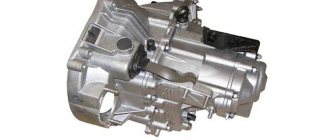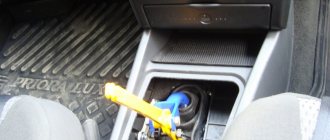The main causes of manual transmission malfunctions
In good condition, a car with a manual transmission accelerates quickly and without jerking. It is worth highlighting the symptoms that a malfunction of the gearbox on the car has occurred:
- one or more gears do not engage;
- changing speeds is difficult;
- “knocks out” the transmission, extraneous noise is heard;
- the appearance of oil smudges under vehicles.
The range of occurrence of these manifestations is quite wide, ranging from gear wear to the use of low-quality gear oil. As a rule, a problem with shaft bearings occurs if vehicles have been in operation for a long time. If they are worn out, noise may occur at idle.
If there is no lubrication on the bearing or there are cracks on the rollers, a whistle may be heard.
The clutch includes a disc and a basket. Malfunctions of the basket may be associated with wear of the “petals”, as a result of which it will overheat, which will affect the efficiency of changing speeds. Gears often fail to shift because the friction linings of the disc have become deformed. Against this background, a drop in power indicators may be observed.
In case of any manifestations, you cannot do without diagnosing the car transmission. This procedure should be entrusted to car service specialists. In some cases, repair work may involve replacing the transmission fluid. Adding new fuel to the existing old one is allowed, but you should use fuel of the same brand that was previously added. Otherwise, mixing liquids of different brands will negatively affect the functioning of the vehicle.
How to change the gear knob on a VAZ 2114
Replacement of the gearshift knob is required only in case of mechanical damage. More often you have to remove and install it to replace a loose cardan or repair a broken lever bushing. The sequence of actions for dismantling the lever is as follows:
- remove the handle cover to open access to the handle mount;
- remove the hatch of the decorative plastic tunnel;
- unscrew the fastening screws;
- remove the plastic tunnel;
- unscrew the lever axle nut;
- remove the axle;
- remove the lever.
To install the lever in place, you need to do the following:
- insert the lever into its original place;
- apply lubricant to the lever axis or to the inner surface of the bushing;
- insert the lever shaft and tighten the nut;
- install a decorative tunnel;
- tighten the screws securing the tunnel;
- install a decorative hatch;
- put the cover on the VAZ 2114 gearbox handle and secure it.
Why did the gearbox shift poorly?
There are several factors that can lead to difficulty shifting gears on a manual transmission. In particular these are:
- clutch problem;
- breakdown of the gear selection mechanism of the gearbox;
- warping of the driven disk;
- wear of synchronizers.
In addition to this, a leak may appear from the box. It seems possible to eliminate the problem with fluid leakage from the gearbox by replacing the rubber seals and the drive shaft seal.
If the problem lies in the clutch, then because of this the reverse gear will engage with a characteristic crash. The clutch fork must be checked. If this component of the box is damaged, it must be replaced. You should also pay attention to the driven disk.
Gears engage poorly even when the gear teeth are worn. In this case, a characteristic noise may be noted when the gear is in gear when the engine is running.
In some cases, adjusting the backstage helps to restore the functioning of the gearbox. This component of the box ensures the connection of the gear lever with the gearbox. If the backstage is deformed, it needs to be replaced. As a rule, in this case there may be not only a problem with shifting gears, but also a large stroke of the gearshift lever itself.
The breakdown of the gear selection mechanism is due to the fact that there is damage to the gears, bearings or synchronizers, i.e. components of the manual transmission.
As for the synchronizers, when they wear out, 1st, 2nd, and 3rd gears do not engage. As a rule, when a change of modes occurs, a characteristic crunching sound becomes clearly audible. Also, manual transmission gears can activate spontaneously.
How to remove rattling gearshift knob (cable manual transmission 2181) Lada Granta and Lada Kalina
Since 2013, AVTOVAZ began installing a modernized mechanical cable gearbox with the index MKPP-2181 on Lada Kalina and Granta cars.
According to the auto giant, modifications to the gearbox made it possible to reduce backlash and make gear shifts clearer. But in practice, car enthusiasts began to notice that the gearshift knob was rattling. In 2013, Lada dealers began to receive numerous complaints from Granta and Kalina owners. Drivers were pointed out a problem with the gearshift knob: when it shakes and vibrates (especially in 3rd and 4th gears), crackling and knocking noises appear. AVTOVAZ issued instruction No. 31-13 (To download files, you need to log in to the website), which stated that in order to solve the rattling of the gearshift knob, it is necessary to replace the gear shift mechanism. But this did not help, nor did replacing the gearbox cables.
At the same time, enthusiasts began to get involved in solving the problem and tried to eliminate the rattling of the gearshift knob with the help of modifications. For example, they put two springs on the cables near the gear shift mechanism, or put polyethylene in the plastic clip of the lever tip, but this also did not bring the desired result.
Soon AVTOVAZ finds another solution to the problem, which it describes in a new information letter No. 23-15 (To download files you need to log in to the site). The modification of the design consisted of placing a damper (dimensions 30x30x50 mm) under the right cable in the tunnel. Dense foam rubber can be used as a damper, which restores its shape after compression.
In October 2016, AVTOVAZ issued another information letter No. 64-16 “On eliminating chatter in the gearbox control drive of LADA vehicles equipped with a cable gear shift drive.” Now, whoever complained about the rattling of the gear shift lever in the control drive, it was proposed to replace the gear shift cables and their mounting bracket.
However, car enthusiasts have found another effective way to remove the rattling of the gearbox handle - tighten the cables with plastic ties. In some cases, it will be sufficient to tighten the two cables together in the engine compartment at the edge of the heat shield.
If the cracking does not stop, further tighten the cables inside the passenger compartment, and then tighten them to the metal plate. Do not overdo it, otherwise the gear knob will be too tight. It is worth noting that the use of plastic ties solves the problem of vibrations and rattling of the gearshift knob in most cases.
Have you encountered a similar problem? How did you manage to get rid of extraneous noise and vibrations? Let us remind you that another popular modification for Lada cars is the installation of additional door seals and firmware for the standard radio.
Source
Precautions for operating a car with manual transmission
In order not to encounter problems with manual transmission, you should not neglect to undergo a technical inspection. To accurately determine the nature of the problem, you need to remove the box to disassemble it and then troubleshoot it.
When the speed decreases, for example, if you are driving uphill, you should switch to a lower gear. This ensures efficient movement over rough terrain.
It is possible to replace worn manual transmission components if the gear does not engage on your own, but you should know the design features of the gearbox.
The frequency of checking the oil level is approximately 15,000 km on a car with a manual transmission. Each individual car model with a manual transmission has its own oil change period. If the machine is used non-aggressively, as well as using high-quality fluid, replacement may be necessary after 50,000 km.
When moving forward, you should not engage reverse gear. This is the main reason that the box failed.
When changing gears, you should fully depress the clutch pedal. Otherwise, the car owner may experience damage to gears and synchronizers.
Principle of operation
The working diagram of the gearbox is as follows. The drive shaft receives rotation from the driven clutch disc and transmits it to the intermediate one. If the gearbox is set to neutral speed, there is no engagement of the intermediate shaft gears with the driven one, the car is immobilized, since rotation is not transmitted.
When a gear is engaged, the driver engages the driven element gear with a specific intermediate gear. And rotation begins to be transmitted from the driven shaft to the wheels. The car starts to move.
The necessary gears are engaged by a control unit consisting of three sliders and forks. Each of the forks is equipped with a special groove of the element. That is, the driver, using the gearshift lever and a special rocker, acts on a certain slider, moving it to one side. In this case, the fork on the slide pushes the gear, and it engages. The change in gear shift speed is influenced by engaging gears of different sizes and numbers of teeth.
To prevent the slider with the fork from returning to its original position, the box control unit is equipped with latches. The latter are spring-loaded balls that fit into grooves on the sliders. That is, the slide has grooves in certain places.
This is a simplified description of the design and operating principle of a manual transmission.
In some cars, the slider in the gearbox, which is responsible for engaging the first gear, also ensures that the reverse gear is engaged. It happens to them that the first and reverse gears are difficult to engage. Of course, this breakdown cannot be ignored.
On other gearboxes, first and reverse speeds are separated and different sliders are responsible for turning them on. In such cars, problems with engaging first gear may not be reflected in engaging reverse gear.
There are several options why first gear does not engage well. It also all depends on how the cause manifests itself - it is impossible to turn it on, and everything is accompanied by a metallic grinding sound from the side of the box, or the speed turns on, but immediately turns off on its own.
Method number 1 - simple
This method is the fastest and easiest. To work you will need about 20 minutes of free time and the following tools:
- key for 13
- pliers
- sharpener
So, first we lift the casing and twist the securing nut. We take it out and carefully fold it, so as not to lose it, the bolt along with the washer and bushing. And we immediately find the cause of the rattling - this design was designed with a small gap between the connections, which is the cause of the vibration.
In order to get rid of the gap as much as possible, you will need to grind off the metal bushing, which will allow the washers to be compressed more tightly. There will be two bushings, and you need to grind off the one that is smaller in size. This must be done very carefully, and not get carried away; you need to grind down to 1 mm, no more. If you overdo it, it will be extremely difficult to move the lever.
Now we coat the parts with auto plasticine and put everything back together. The parts should also be connected carefully, since if you squeeze too hard, it will be difficult to change gears, and if you don’t squeeze too hard, the structure will wobble and also rattle. After we get into the car and do a short test drive, the vibration and noise should disappear, if the result is not completely satisfactory, then you can do everything again, since the whole procedure will take a maximum of 20 minutes.
Poor activation due to the slider
First, let's look at why first gear doesn't engage well and the problem is with the transmission.
Often the problem with turning on the speed lies in the latch and slider. The appearance of a burr near the groove for the retainer on the slide can easily prevent the ball retainer from entering the groove. When moving the slider, the latch rests on this burr and cannot overcome it without significant effort from the driver. In this case, the gears come very close to each other, but do not engage, and the teeth of one gear hit the other.
Knocking out the speed
If it turns on, but immediately turns off, then the latch may be stuck in the squeezed position, so it no longer does its job. It is also possible that the spring that presses the ball retainer is destroyed. Without the force of the spring, it will not be able to hold the slider in the desired position.
If significant force is applied while shifting into gear, the shift fork may bend.
Poor switching may also be caused by incorrect installation of the gearshift knob. In this case, the rocker does not bring the gear to full engagement.
How to remove rattling gearshift knob (cable manual transmission 2181) Lada Granta, Kalina 2
May 03, 2022 LadaOnline 35 458 Since 2013, AvtoVAZ began installing a modernized mechanical cable transmission with the manual transmission index 2181 on Lada Kalina and Granta cars. According to the auto giant, modifications to the gearbox made it possible to reduce backlash and make gear shifts clearer. But in practice, car enthusiasts began to notice that the gearshift knob was rattling.
In 2013, Lada dealers began to receive numerous complaints from Granta and Kalina owners. Drivers were pointed out a problem with the gearshift knob: when it shakes and vibrates (especially in 3rd and 4th gears), crackling and knocking noises appear.
AvtoVAZ issued instruction No. 31-13 (To download files you need to log in to the site), which stated that in order to solve the rattling of the gearbox handle, it is necessary to replace the gear shift mechanism.
But this did not help, nor did replacing the gearbox cables.
At the same time, enthusiasts began to get involved in solving the problem and tried to eliminate the rattling of the gearshift knob with the help of modifications. For example, they put two springs on the cables near the gear shift mechanism, or put polyethylene in the plastic clip of the lever tip, but this also did not bring the desired result.
Soon AvtoVAZ finds another solution to the problem, which it describes in a new information letter No. 23-15 (To download files you need to log in to the site). The modification of the design consisted of placing a damper (dimensions 30x30x50 mm) under the right cable in the tunnel. Dense foam rubber can be used as a damper, which restores its shape after compression.
However, car enthusiasts have found another effective way to remove the rattling of the gearbox handle - tighten the cables with plastic ties. In some cases, it will be sufficient to tighten the two cables together in the engine compartment at the edge of the heat shield.
If the cracking does not stop, further tighten the cables inside the passenger compartment, and then tighten them to the metal plate. Do not overdo it, otherwise the gear knob will be too tight. It is worth noting that the use of plastic ties solves the problem of vibrations and rattling of the gearshift knob in most cases.
we eliminate the chatter of the gearbox handle by tightening the cables in the cabin we eliminate the chatter of the gearbox handle by tightening the cables in the cabin
Have you encountered a similar problem? How did you manage to get rid of extraneous noise and vibrations? Let us remind you that another popular modification for Lada cars is the installation of additional door seals and firmware for the standard radio.
Photo source: AlexFri in-flight magazine
Keywords: Lada Granta gearbox | gearbox Lada Kalina 2 | soundproofing of Lada Granta | sound insulation of Lada Kalina 2 | Lada Granta tunnel | tunnel Lada Kalina 2 | AvtoVAZ order
00Found an error? Select it and press Ctrl+Enter..
Similar materials
- Reviews of French manual transmissions JH3 and JR5 (Vesta, Largus, XRAY)
- Mechanical cable transmission Lada Granta, Kalina 2 (device and reviews)
- Where does the gearbox whine come from Lada Granta, Kalina 2 (manual transmission-2181)
Troubleshooting gearbox
Troubleshooting the gearbox is done by removing it from the car, disassembling it, and troubleshooting parts if it is found that some of them are badly worn. Particular attention should be paid to the condition of the sliders and clamps. If burrs are noticed on the sliders, they must be removed with a file. You also need to check the condition of the springs and retainer balls. The springs must be intact, and the latch must move without problems in its seat. If necessary, worn or damaged elements must be replaced.
You should also carefully inspect the power forks for bending. Even a slight bend can affect the ease of gear engagement.
After assembly, gear shift adjustment must also be performed. To be precise, the position of the scenes is set.
How to repair the Lada Granta gearbox shift drive
1. Using a 13 mm socket wrench, unscrew the two nuts securing the bracket.
2. Using a 13 mm socket wrench, unscrew the bolt securing the torque rod to the base of the ball joint of the gearshift lever, holding the bolt nut with a 13 mm socket wrench.
We also unscrew the second bolt securing the jet rod.
3. We remove the rod from the gear shift lever support.
4. Use a 13 mm wrench to loosen the torque clamp.
Having disconnected its tip from the rod, remove the rod.
5. If necessary, use a 19 mm socket wrench to unscrew the two nuts securing the torque arm bracket, holding the bolt heads with a wrench of the same size.
Remove the bracket assembly with the tip of the torque rod
We install the jet thrust in the reverse order.
Clutch faults
Often the reason why first gear does not engage well is not the gearbox itself, but the clutch.
Modern gear transmissions are equipped with synchronizers that equalize the speed of rotation of the gears, ensuring ease of engagement.
However, the first speed is not equipped with a synchronizer. If the clutch “drives”, then when the pedal is depressed, the transmission of torque from the engine to the gearbox does not completely stop.
Because of this, there is a difference in the rotation of the shafts and gears of the first gear, in particular.
It is quite possible that the reverse gear will also not engage, or it will be difficult to engage. Moreover, if you manage to engage the gear, the car begins to move even with the clutch pedal fully depressed. An additional sign of clutch problems is that the car jerks when changing gears, especially if any of the gears do not have synchronizers.
Hidden text
Today I went for a ride with IPG. He said that everything was within tolerance, there was no malfunction.
Does this problem fall under AvtoVAZ's regulations?
Today I went for a ride with IPG. He said that everything was within tolerance, there was no malfunction.
Does this problem fall under AvtoVAZ's regulations?
Finally got around to eliminating the rattling of the gearshift lever when driving in 3.4 gears. To be fair, it should be noted that before this I tried everything to eliminate this unpleasant rattling noise: I put two springs on the cables near the gear shift mechanism, put foam rubber under the cables (as the factory prescribed in the letter), put a 2 mm washer (maybe it was necessary to have 3 mm place the washer) under the stop (with the ball) of the three-dimensional plate, put polyethylene in the plastic holder of the lever tip - nothing helped, it rattled very much. I asked the OD warranty workers about this problem, they said that they don’t change the transmission cables now because they are useless and VAZ forbade them to do this. In the end, I solved the problem (at their suggestion) with ordinary plastic ties. The essence of the “revision” is as follows: the cables are tightened with one tie in the engine compartment and 4-5 ties in the cabin - from the engine shield to the strip with a clamp under the heater air duct. Driving after this “revision” showed a complete absence of acoustic rattling of the lever in all modes, especially when accelerating under load, which always led to nasty rattling. Even the transmissions began to turn on more clearly - for me, that’s just the thing. I don’t know how the lever will behave in the future, but at the moment I’m happy with everything. The most surprising thing is that the solution to the problem is cheap, but, in my case, when nothing else helps, it is very effective.
Source
How to check the clutch?
The car engine can help indicate a malfunction of the clutch, not the gearbox. If, with the engine turned off, all speeds are switched on easily, no problems arise, but when the engine is running, first and reverse gears are difficult to engage, or impossible to engage at all, you should pay attention to the clutch.
The reason that the clutch “leads” is often due to its incorrect adjustment.
Clutch adjustment and repair
The first thing to do if you have problems with the clutch is to make an adjustment.
If the adjustment does not help, then you will have to dismantle the clutch from the car, carry out troubleshooting and replace worn elements. Sometimes, over time, all components of the system wear out. In this case, the clutch is completely replaced - the drive and driven discs, the release bearing.
How to eliminate the rattling of the VAZ 2114 gearbox handle
Often, the VAZ 2114 gear knob resonates with the operation of the engine and makes an unpleasant rattling sound due to the following problems with the bushing:
In the first case, you will have to change the plastic inserts or the bushing assembly. In the second, you will have to bring the dimensions into line. To do this you will need a file, electrical tape and a vice. Often the manufacturer installs a bushing, which with its edges touches the traction fork (stage) and knocks on it when it vibrates. To get rid of noise, you need to do the following:
After such an operation, all that remains is to put on the plastic inserts and put the gearshift knob in place. The edges of the bushing will no longer touch the metal fork and the VAZ 2114 gear knob will stop rattling.
For what reasons do interruptions occur?
There can be many reasons why gears do not shift when the engine is running. However, all of them, in one way or another, are connected with the two most important units of the car - the engine or gearbox. In case of serious damage, you should contact a good car service.
If the problem is in the gearbox, it will need to be removed for further disassembly and troubleshooting. If the problem is with engine components, they may need to be replaced. However, there are cases when, to eliminate a malfunction, it is enough to carry out preventive maintenance: removal, lubrication and careful adjustment of the components.
But what if you turn to professionals?
Since the gearbox installed on the Lada Grant is cable driven, the only solution offered at the service station is to replace the cable.
The procedure is quite expensive, since workers will need a lot of time to replace. In addition, replacing the cable is not very effective - only the rattling disappears, but the vibration remains. And one more thing - a new cable will last for about 3-4 thousand kilometers, and then again you will have to go to a service station, which will lead to new expenses and another loss of time.
How does AVTOVAZ comment on this problem?
It is worth noting that the AVTOVAZ plant constantly holds so-called “Quality Days”, which you can visit and contact management with your complaints and suggestions. On one of these days, members of the Lada car lovers club expressed their complaints about the rattling gearbox. In response, it was stated that a more ergonomic cable drive is currently being developed. The design will use flexible cables, which will make it virtually impossible to transfer vibrations to the gearbox itself, so we will wait for the new product. Until then, we will fight the problem ourselves.
Problems with switching to automatic transmission
Shifting problems with automatic transmissions are not uncommon. Problems with the automatic machine arise for several reasons.
- backstage malfunction . This mechanism is the most problematic in old-type automatic transmissions. To eliminate the malfunction, the unit will need to be replaced. In most cases, it will be necessary to dismantle the gearbox for these purposes;
- insufficient oil level . The presence of lubricant leaks on the automatic transmission housing may indicate wear of the sealing gaskets, which are not difficult to replace yourself. After this, you need to change the oil in the box. Also, owners of cars with an automatic transmission are recommended to visually inspect the gearbox for oil leaks at least once every 2000 km;
- problems with the transmission control unit can ultimately cause the automatic transmission to completely lock up. To fix the problem, you will need to replace the failed mechanism and thoroughly inspect the electrical part of the gearbox.
Important! To solve problems with automatic transmission, it is recommended to conduct computer diagnostics of transmission faults.
AvtoVAZ recommendations for VAZ-2108, 2109
INSTRUCTIONS for checking the noise of gearboxes of VAZ-2108, 2109 cars
When an owner makes a complaint about gearbox noise, it is necessary to check the vehicle in the following sequence:
- Check the level and quality of oil in the gearbox - the brand of oil must correspond to the recommended one.
- Check that the ignition and idle speed are adjusted correctly. Engine idling must be stable, the speed must correspond to the required (750...800 rpm).
- Check the noise level at idle by sequentially engaging and disengaging the clutch while the vehicle is stationary. In this case, the noise level in the cabin is compared with the clutch engaged and disengaged.
- Assess the noise of the gearbox in motion in all gears with uniform movement, acceleration and engine braking.
The presence of light noise in the form of a “fractional knock” or “rattling” when the engine is idling, as well as when driving at low intensity acceleration or when braking the engine is not a sign of abnormal operation of the gearbox and a reason for rejection if the noise disappears when the engine speed increases or load. These noises occur when the gearbox operates with light loads or at idle and are a feature of the gearboxes of front-wheel drive cars, both VAZ-2108, 2109, and foreign analogue cars, due to the presence of a rigid short transmission and the use of low-viscosity oil to reduce fuel consumption and increase ease of use in winter conditions.
The increased noise (howling) of the second gear gears in comparison with other gearbox gears, which is caused by the location of the second gear gears in the middle part of the shafts, which has the greatest deformations, is also not a defect.
These noises do not affect the reliability and durability of transmission components and cannot serve as a basis for complaints.
It is necessary to distinguish the gearbox noise described above from other extraneous noises and knocks associated with defects in gears, shafts and bearings, which are heard in other conditions and have a different nature. In this case, the gearbox requires repair.
Shift lever vibrations
A slight increase in the level of vibration of the gear shift lever, the appearance of a characteristic sound, hum, etc. in the car interior at an engine speed of 2000÷2200 rpm refers to an acoustic defect, and not a design defect of the VAZ-2108, 2109 family of cars for the following reasons:
- there is no direct connection between levels and vibrations and the reliability and service life of components;
- The level of vibration of the gear shift lever on a moving vehicle is regulated by GOST 12.1.012-90 “Vibration Safety”, section “Local Vibration”. All assessments of cars of the VAZ-2108, 2109 family for compliance with the requirements of the specified GOST are positive.
- The vibration level of the gear shift lever at engine idle speed is regulated only by the so-called subjectively acceptable level of vibration acceleration developed by VAZ STC specialists.
- The noise level in the car interior is regulated by the current GOST 27435-87 within 80 dBA. The assessment is carried out in the “acceleration” mode in third gear in the speed range of 49…104 km/h. Selective periodic monitoring of assembly line vehicles shows that the internal noise level averages 79º dBA, which meets the requirements of the standard.
The causes of these acoustic defects are both structural, technological and operational factors, but not defects.











